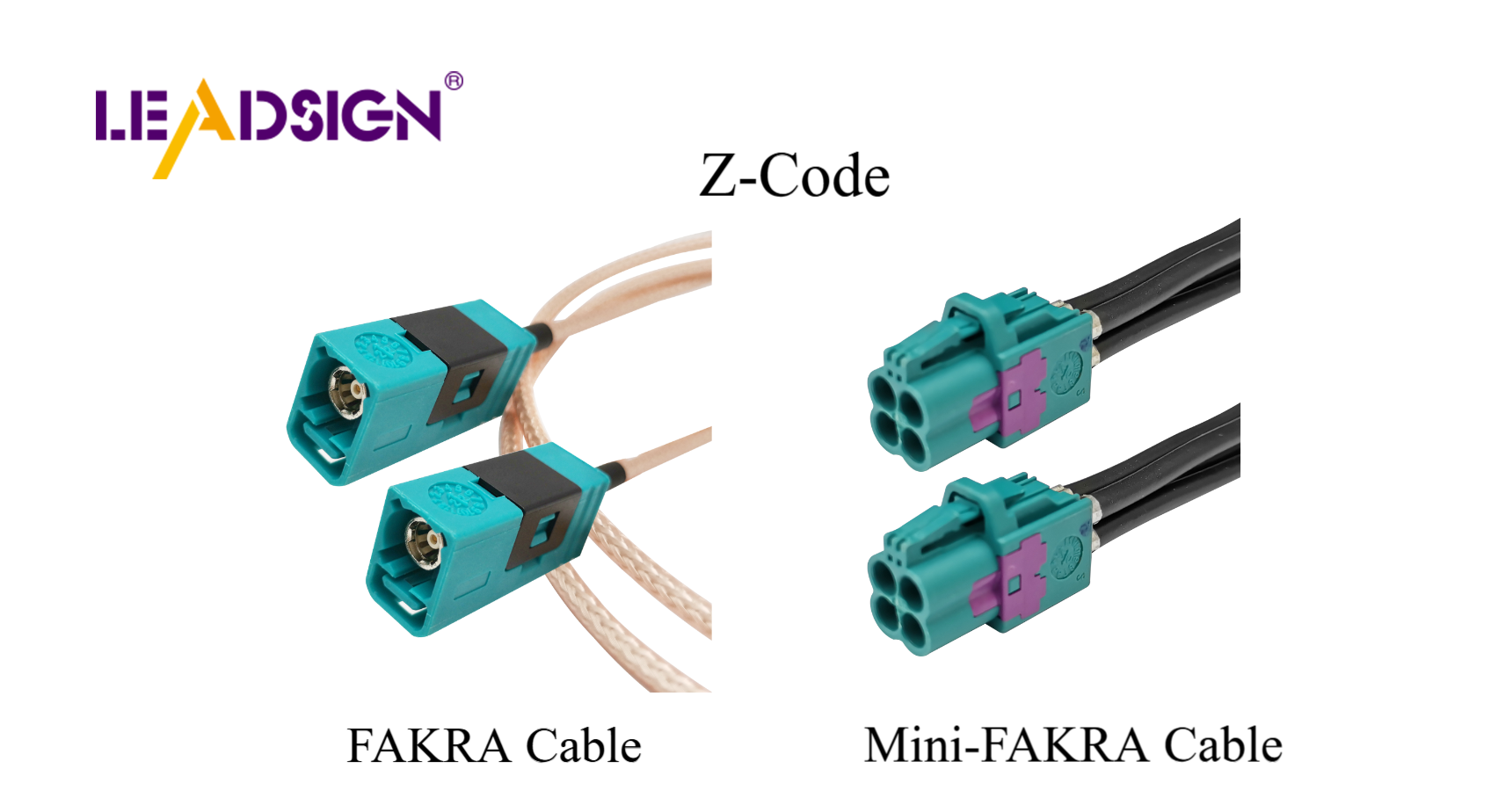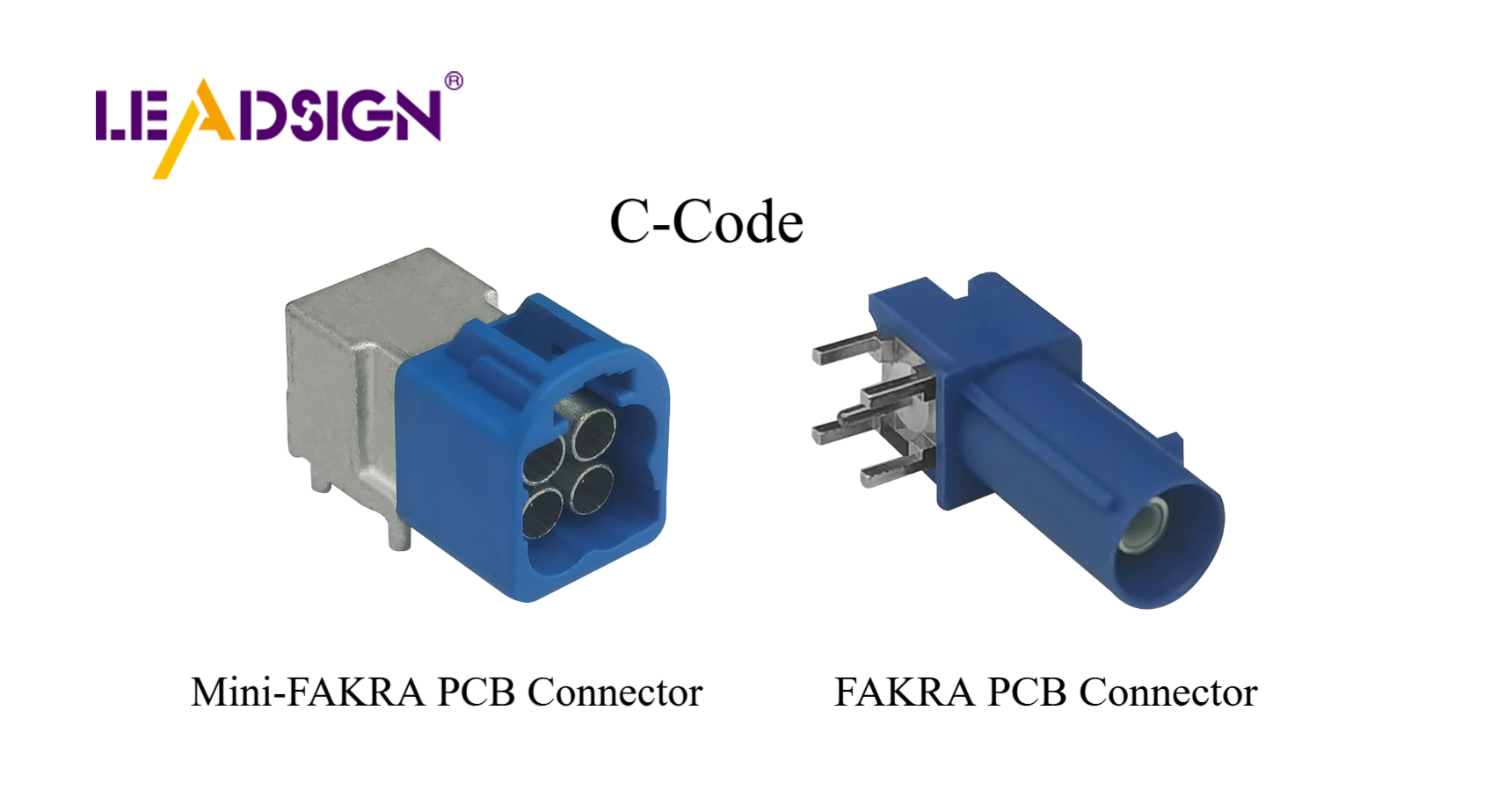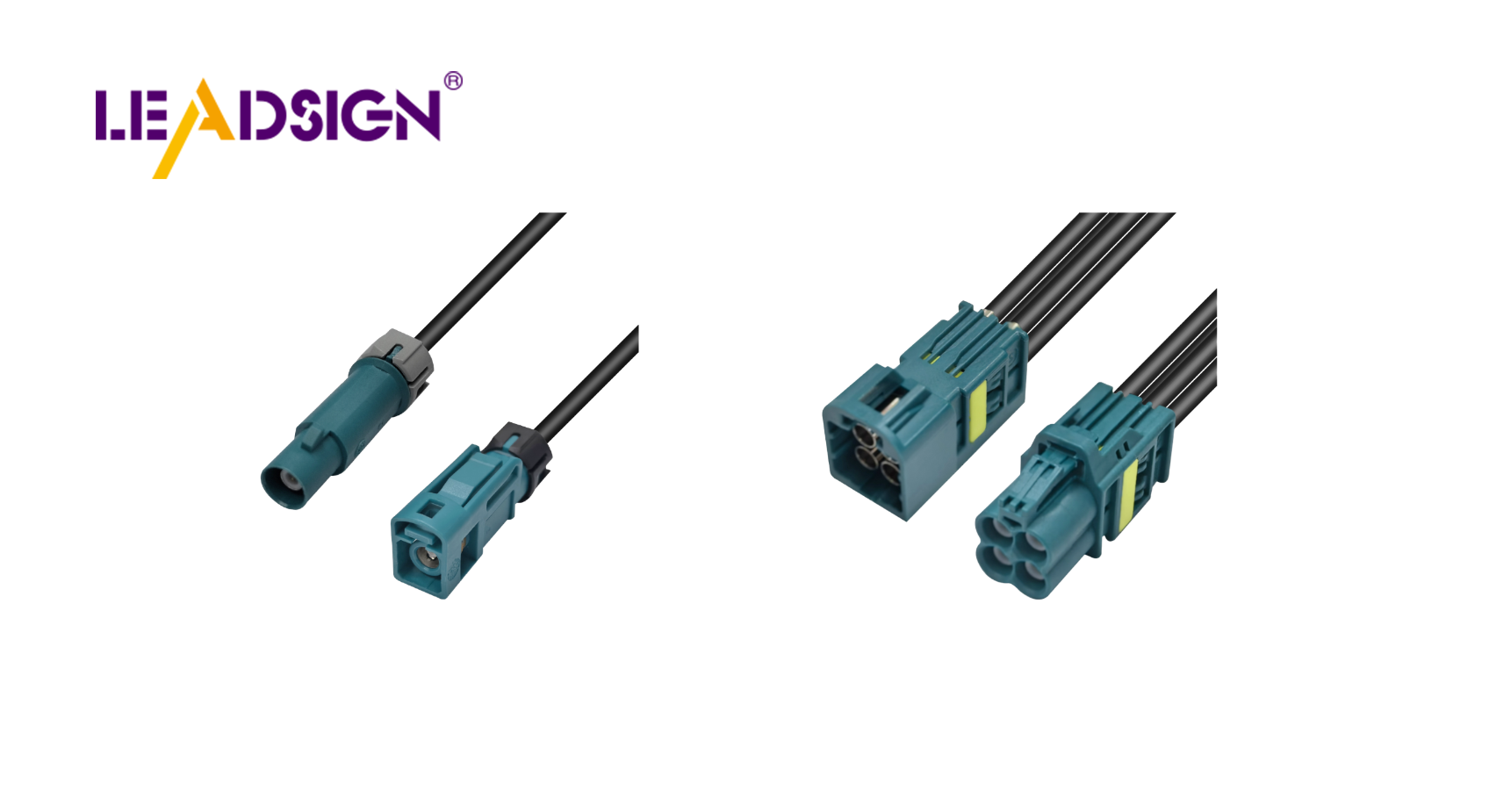50 Ohm Coax Cable Types Is Mini FAKRA the Future?

FAKRA vs Mini FAKRA: A Detailed Comparison
Comparing FAKRA and Mini FAKRA connectors for future coax cable needs
Features | FAKRA | Mini FAKRA |
|---|---|---|
Size | Standard size, multiple housings | Smaller size, 80% space savings |
Frequency Range | Up to 6 GHz | Up to 20 GHz |
Data Rates | Up to 8 Gbps | Up to 28 Gbps |
Mating Cycles | ≥ 25 | Up to 25 |
Space Savings | Multiple housings for space savings | 80% space savings |
Frequency Support | Up to 6 GHz | Up to 20 GHz |
Speed | Up to 8 Gbps | Up to 28 Gbps |
Weight | Standard weight | Lightweight design |
Applications | Radio antenna, GPS, infotainment | Self-driving, ADAS, navigation |
Technology keeps needing smaller and faster solutions. Mini-FAKRA connectors solve this with small designs and great performance. They use 80% less space than regular FAKRA connectors, making them perfect for today's car systems. They can handle data speeds up to 28 Gbps and work with frequencies as high as 20 GHz. Mini-FAKRA connectors are changing what 50 ohm coax cable types can do. More cars now use them in self-driving and driver assistance systems, showcasing their importance for future connections.
Key Takeaways
Mini-FAKRA connectors are 80% smaller than standard FAKRA connectors, making them ideal for modern vehicles with limited space.
They support data speeds of up to 28 Gbps and frequencies up to 20 GHz, enabling advanced applications like self-driving and driver assistance systems.
The durable design of Mini-FAKRA connectors ensures reliable performance in harsh conditions, such as heat and vibrations.
Their modular design allows for easy upgrades and adaptations to new technologies, ensuring future readiness.
Investing in Mini-FAKRA connectors can lead to long-term cost savings by reducing material costs and minimizing maintenance needs.
Mini-FAKRA connectors are becoming essential in various industries, including automotive, telecommunications, and aerospace, due to their superior performance.
Understanding 50 Ohm Coax Cable Types

What are 50 Ohm coax cables?
50 Ohm coax cables are used to send signals reliably. They carry RF and microwave signals with great efficiency. These cables have four parts: a center wire, an insulator, a shield, and an outer cover. This design helps reduce signal loss and blocks interference.
The 50 Ohm standard is important for RF systems. It balances power use and signal quality for high-frequency tasks. You can find these cables in radios, ham setups, and microwave systems. They handle high voltage and power well, making them useful in many industries.
In cars, coaxial cables are strong and resist interference. For years, they’ve been used for GPS and radio antennas. New connectors like FAKRA make them even better for modern vehicles.
The role of FAKRA connectors in coaxial cable systems
FAKRA connectors are key in car and telecom systems. They keep RF connections secure and stable. You’ll see them in GPS antennas, entertainment systems, and keyless entry.
FAKRA connectors stand out because of their tough design. Their coding system stops mistakes during assembly. Locking mechanisms keep connections safe in tough conditions. They work with frequencies up to 6 GHz and speeds up to 8 Gbps.
In cars, FAKRA is the go-to connector for large coax cables. They block interference well and give steady signals for reliable use in vehicles. Over time, they’ve proven great for radios to advanced driver-assist systems.
As tech improves, standard FAKRA has limits that led to Mini-FAKRA designs. These smaller connectors save space while working better for future cable needs.
Exploring FAKRA Connectors
What are FAKRA connectors?
FAKRA connectors are special RF connectors made for cars and telecom systems. They send signals reliably even with vibrations or temperature changes. Their strong design makes them great for GPS, satellite radio, and infotainment systems.
The FAKRA standard helps different brands work together easily. It uses 14 color-coded and mechanical parts to avoid mismatches. This system also makes it simple to identify connector types. FAKRA connectors can handle both power and analog signals, making them useful in many car systems.
Key features and benefits of FAKRA terminals
FAKRA connectors have important features that make them essential today:
Durability: Built tough, they work well in harsh conditions like heat or vibration.
Color-Coding System: Colors help quickly match the right connector type.
Mechanical Keying: Stops wrong connections for safe and secure use.
Versatility: Comes in different shapes to fit various mounting needs.
Global Standardization: Approved worldwide by major car makers and suppliers.
These features improve performance while reducing buying challenges by allowing easy swaps between brands.
Applications of FAKRA connectors in automotive and telecommunications
FAKRA connectors connect key parts in cars and telecom networks. They are used for:
Automotive Systems:
GPS antennas for maps
Satellite radio and entertainment
Cameras for safety driving
Tire pressure monitoring
Remote start systems
Telecommunication Systems:
Sending high-frequency RF signals
Mobile device connections
Linking ECU with other modules
Their flexibility lets them handle many signals, supporting today's tech needs. They keep steady connections even under tough conditions, making them reliable for vehicles and communication setups.
Standard FAKRA Connectors: Challenges in Modern Systems
Standard FAKRA connectors work well but have some drawbacks. As cars and tech improve, these issues become more noticeable.
Space Issues
Standard FAKRA connectors are big and need a lot of room. Modern vehicles need smaller parts for systems like self-driving and entertainment.Speed Limits
They can send data up to 8 Gbps, but that’s slow for newer systems. Things like real-time maps and safety features need faster speeds.Frequency Cap
These connectors handle up to 6 GHz frequencies, which works for GPS or radios. But new tech like radar needs higher frequency support.Future Growth Problems
Their design makes it hard to grow with future needs. Cars now use more sensors, so compact connectors are better for handling many signals.Weight Factor
Reducing weight helps cars save fuel and perform better. Standard connectors are heavy, making them less ideal for lightweight designs.
Even with these limits, they’re still useful today. But Mini-FAKRA connectors solve these problems by being smaller, faster, and more flexible for future systems.
The Rise of Mini-FAKRA Terminals

What are Mini-FAKRA terminals?
Mini-FAKRA terminals are the latest in connector tech. They are smaller than regular FAKRA connectors but work just as well. These connectors still have 50 Ohm impedance but perform even better. They can handle frequencies up to 20 GHz and data speeds of 28 Gbps, making them great for fast data transfer.
Their tiny size saves up to 80% more space compared to standard FAKRA connectors. This makes them perfect for cars where space is tight. Even though they are small, Mini-FAKRA terminals keep signals strong and stable, working well in tough conditions.
Advantages of Mini-FAKRA connectors over standard FAKRA
Mini-FAKRA connectors have many benefits that make them better than standard ones. These features solve old problems and fit new technology needs:
Compact Design
Mini-FAKRA connectors take up less room in vehicles. Engineers can add more parts without losing function.Higher Data Speeds
Standard FAKRAs reach 8 Gbps, but Mini-FAKRAs hit 28 Gbps. This helps with real-time systems like self-driving cars.Wider Frequency Range
They work at frequencies up to 20 GHz, unlike standard ones capped at 6 GHz. This suits radar and high-quality cameras.Weight Reduction
Their lightweight design lowers vehicle weight, improving fuel efficiency and energy savings.Future-Ready Design
Built for future tech, their modular build adapts easily to new needs.
Applications and industries adopting Mini-FAKRA terminals
Mini-FAKRA connectors are becoming popular in many fields due to their advanced features:
Automotive Industry
Used in self-driving systems, ADAS, infotainment setups, and navigation tools. Their small size fits multiple sensors and cameras into vehicles.Telecommunications
Help send high-frequency RF signals for smooth communication between devices in networks or data centers.Consumer Electronics
Great for gadgets needing fast data transfer due to their speed capabilities.Aerospace and Defense
Reliable for radar systems, communication gear, and navigation tools where performance matters most.
The growth of Mini-FAKRA shows how they solve modern challenges with ease. Their small size, excellent performance, and flexibility make them essential for the future of connectivity.
FAKRA vs Mini FAKRA: A Simple Comparison
Size and design differences between FAKRA and Mini-FAKRA connectors
FAKRA and Mini-FAKRA connectors differ a lot in size. FAKRA connectors are small but still need more space to install. They are strong and reliable, making them good for many car uses. But as cars add new systems, smaller parts are now needed.
Mini-FAKRA connectors solve this problem with their tiny size. They use 80% less space than regular FAKRAs. This lets engineers fit more parts into tight areas without losing function. Even though they’re smaller, Mini-FAKRAs stay tough and work well in hard conditions. This makes them perfect for modern cars where saving space is important.
Performance and technical specifications of FAKRA vs Mini-FAKRA
Mini-FAKRAs perform better than regular ones in many ways. Standard FAKRAs handle up to 6 GHz frequencies and 8 Gbps speeds. These limits work fine for things like GPS or radios in cars today. But newer tech needs faster speeds and higher frequencies.
Mini-FAKRAs can handle up to 20 GHz frequencies and 28 Gbps speeds. This makes them great for advanced systems like self-driving cars or high-quality cameras. Their better performance helps send data quickly, which is very important for modern car systems.
Cost considerations for FAKRA and Mini-FAKRA terminals
Cost matters when picking between these two types of connectors. Regular FAKRAs cost less because they’re common and easy to make. They are affordable and work well for older systems that don’t need fast data or high frequencies.
Mini-FAKRAs cost more at first due to their advanced design. But they save space, lower weight, and prepare systems for the future, which saves money later on. For industries using new tech, investing in Mini-FAKRAs can improve system efficiency over time.
Future-ready and Flexible Mini-FAKRA Connectors
Mini-FAKRA connectors are made for today’s tech and future needs. Their small size and strong performance make them great for industries needing fast data transfer and space-saving designs. These connectors aren’t just for now; they’re built to grow with new technologies.
1. Fit for New Technologies
Mini-FAKRA connectors work well with advanced systems like self-driving cars, ADAS, and HD cameras. They handle up to 20 GHz frequencies and 28 Gbps speeds, making them ready for the latest tech. As industries change, these connectors can easily adapt to new systems.
For instance, AUTOMATE Type A Mini-FAKRA connectors perform reliably up to 9 GHz. They are perfect for robots and other high-tech uses.
2. Space-Saving Design
Mini-FAKRA connectors use 80% less space than regular ones. This lets engineers add more parts in tight areas without losing function. As devices get more complex, saving space is key for adding sensors, cameras, or communication tools.
3. Easy System Upgrades
These connectors have a modular design that allows simple upgrades or expansions. This makes it easy to keep systems updated as new features come out. Adding sensors or improving networks becomes quicker and cheaper with these connectors.
4. Built to Last
Mini-FAKRA connectors can handle tough conditions like heat or vibrations. Their durable build means they last longer, cutting down on repairs or replacements over time.
5. Works with Many Systems
The standardized design of Mini-FAKRA ensures they fit with different brands easily. This makes switching or adding them simple as industries move toward connected systems worldwide.
Is Mini FAKRA the Future of 50 Ohm Coax Cable Types?
Current trends driving the adoption of Mini-FAKRA connectors
Cars today need smaller and smarter parts. Mini-FAKRA connectors help by being tiny but powerful. They use 80% less space than regular FAKRA connectors. This lets engineers fit more parts into cars without losing features.
Modern cars have systems like self-driving and safety tools. These systems need fast data and high frequencies to work well. Mini-FAKRA connectors send data at speeds up to 28 Gbps. They also handle frequencies as high as 20 GHz, making them perfect for cameras, radar, and entertainment systems.
Lighter designs are also important for cars now. Mini-FAKRA connectors weigh less, helping cars save fuel and energy. As industries focus on being eco-friendly, these connectors support better performance with less environmental impact.
Challenges and limitations of Mini-FAKRA terminals
Mini-FAKRA connectors are great but can be costly at first. Their advanced design makes them more expensive than regular ones. For companies with small budgets, this can slow down their use.
Switching from standard FAKRAs to Mini-FAKRAs might need redesigning some car parts. This takes time and money but is worth it in the long run.
Another issue is how well they work in tough conditions. They are strong but must stay reliable in heat or vibrations. Careful testing helps make sure they perform well everywhere.
Final verdict: Why Mini FAKRA is likely the future standard
Mini-FAKRA connectors seem perfect for modern cars’ needs. They save space, work fast, and adapt easily to new tech demands.
The car industry wants better designs that save fuel and lower emissions. Lightweight Mini-FAKRAs match these goals while supporting many systems in connected vehicles.
Mini FAKRA connectors are changing how cars connect. They are small, send data quickly, and work with frequencies up to 20 GHz. These connectors save 80% more space than regular FAKRA ones. This helps engineers create better and smarter car systems. Their tough design makes them reliable for features like self-driving and safety tools. As car technology grows, Mini FAKRA connectors lead the way for 50 Ohm coaxial cables with great performance and flexibility.
FAQ
How are Mini-FAKRA connectors different from standard ones?
Mini-FAKRA connectors are smaller and work better than standard ones. They save 80% more space compared to regular FAKRA connectors. Standard FAKRAs handle up to 6 GHz and 8 Gbps speeds. Mini-FAKRAs, however, manage up to 20 GHz and 28 Gbps speeds. This makes them perfect for systems needing fast data and less space.
Why do cars need Mini-FAKRA connectors?
Mini-FAKRA connectors help cars share data quickly and reliably. They connect advanced systems like self-driving, safety tools, and entertainment setups. Their ability to handle high frequencies keeps signals clear between cameras, sensors, and other parts.
How can I pick the right connector for my car?
Think about what your car needs before choosing a connector. For modern tech like ADAS or HD cameras, Mini-FAKRAs are better because they’re faster and smaller. Older systems with slower data needs may work fine with standard FAKRAs. Check the space available and future upgrades when deciding.
Can Mini-FAKRA connectors handle tough conditions?
Yes, Mini-FAKRAs are made to last in harsh environments. They can deal with heat, vibrations, and other challenges easily. Their strong design ensures they work well in cars where reliability matters most.
Which industries use Mini-FAKRA connectors the most?
The car industry uses these connectors the most for things like navigation or self-driving features. Other fields like telecoms, aerospace, and electronics also use them for their speed and small size.
What’s happening in the global market for Mini-FAKRAs?
The demand for Mini-FAKRAs is growing worldwide. In 2023, their market was worth $24 million but could reach $36 million by 2030 with a growth rate of 5.6%. This shows how important they’re becoming in vehicles and other industries.
Are these connectors ready for future car technologies?
Yes! Mini-FAKRAs are designed to fit new tech easily. Their modular build allows upgrades as needed. They support fast data transfer for innovations like real-time maps or driver-assist systems.
Are they cost-effective over time?
Even though they cost more upfront, they save money later on. Their small size cuts material costs while lasting longer without frequent replacements or fixes.
How do they improve vehicle connections?
Mini-FAKRAs make vehicle connections faster and more efficient in less space. They send data quicker at higher frequencies than regular FAKRAs.
Do they help make lighter cars?
Yes! Their lightweight design helps reduce overall vehicle weight. This improves fuel efficiency while supporting eco-friendly goals in modern car designs.
See Also
Why Quad Mini Fakra Connectors Matter in Vehicles
Significance of FAKRA Coaxial Cables in Automotive Use
Exploring the Flexibility and Advantages of FAKRA Connectors

